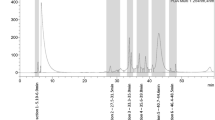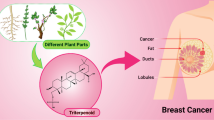Abstract
Purpose
To examine the in vitro anticancer activity of Melaleuca alternifolia (tea tree) oil (TTO), and its major active terpene component, terpinen-4-ol, against two aggressive murine tumour cell lines, AE17 mesothelioma and B16 melanoma.
Methods
Effects of TTO and terpinen-4-ol on the cellular viability of two tumour cell lines and fibroblast cells were assessed by MTT assay. Induction of apoptotic and necrotic cell death was visualised by fluorescent microscopy and quantified by flow cytometry. Tumour cell ultrastructural changes were examined by transmission electron microscopy and changes in cell cycle distribution were assessed by flow cytometry, with changes in cellular morphology monitored by video time lapse microscopy.
Results
TTO and terpinen-4-ol significantly inhibited the growth of two murine tumour cell lines in a dose- and time-dependent manner. Interestingly, cytotoxic doses of TTO and terpinen-4-ol were significantly less efficacious against non-tumour fibroblast cells. TTO and terpinen-4-ol induced necrotic cell death coupled with low level apoptotic cell death in both tumour cell lines. This primary necrosis was clarified by video time lapse microscopy and also by transmission electron microscopy which revealed ultrastructural features including cell and organelle swelling following treatment with TTO. In addition, both TTO and terpinen-4-ol induced their inhibitory effect by eliciting G1 cell cycle arrest.
Conclusion
TTO and terpinen-4-ol had significant anti-proliferative activity against two tumour cell lines. Moreover, the identification of primary necrotic cell death and cell cycle arrest of the aggressive tumour cells highlights the potential anticancer activity of TTO and terpinen-4-ol.






Similar content being viewed by others
References
Wagner KH, Elmadfa I (2003) Biological relevance of terpenoids. Overview focusing on mono-, di- and tetraterpenes. Ann Nutr Metab 47:95–106
Paduch R, Kandefer-Szerszen M, Trytek M, Fiedurek J (2007) Terpenes: substances useful in human healthcare. Arch Immunol Ther Exp (Warsz) 55:315–327
Gershenzon J, Dudareva N (2007) The function of terpene natural products in the natural world. Nat Chem Biol 3:408–414
Markman M, Mekhail TM (2002) Paclitaxel in cancer therapy. Expert Opin Pharmacother 3:755–766
Clark SS, Perman SM, Sahin MB, Jenkins GJ, Elegbede JA (2002) Antileukemia activity of perillyl alcohol (POH): uncoupling apoptosis from G0/G1 arrest suggests that the primary effect of POH on Bcr/Abl-transformed cells is to induce growth arrest. Leukemia 16:213–222
Yeruva L, Pierre KJ, Elegbede A, Wang RC, Carper SW (2007) Perillyl alcohol and perillic acid induced cell cycle arrest and apoptosis in non small cell lung cancer cells. Cancer Lett 257:216–226
Elegbede JA, Flores R, Wang RC (2003) Perillyl alcohol and perillaldehyde induced cell cycle arrest and cell death in BroTo and A549 cells cultured in vitro. Life Sci 73:2831–2840
Burke YD, Ayoubi AS, Werner SR, McFarland BC, Heilman DK, Ruggeri BA, Crowell PL (2002) Effects of the isoprenoids perillyl alcohol and farnesol on apoptosis biomarkers in pancreatic cancer chemoprevention. Anticancer Res 22:3127–3134
Stark MJ, Burke YD, McKinzie JH, Ayoubi AS, Crowell PL (1995) Chemotherapy of pancreatic cancer with the monoterpene perillyl alcohol. Cancer Lett 96:15–21
Da Fonseca CO, Masini M, Futuro D, Caetano R, Gattass CR, Quirico-Santos T (2006) Anaplastic oligodendroglioma responding favorably to intranasal delivery of perillyl alcohol: a case report and literature review. Surg Neurol 66:611–615
da Fonseca CO, Schwartsmann G, Fischer J, Nagel J, Futuro D, Quirico-Santos T, Gattass CR (2008) Preliminary results from a phase I/II study of perillyl alcohol intranasal administration in adults with recurrent malignant gliomas. Surg Neurol 70:259–266 discussion 266–267
Ogbourne SM, Suhrbier A, Jones B, Cozzi SJ, Boyle GM, Morris M, McAlpine D, Johns J, Scott TM, Sutherland KP, Gardner JM, Le TT, Lenarczyk A, Aylward JH, Parsons PG (2004) Antitumor activity of 3-ingenyl angelate: plasma membrane and mitochondrial disruption and necrotic cell death. Cancer Res 64:2833–2839
Hampson P, Chahal H, Khanim F, Hayden R, Mulder A, Assi LK, Bunce CM, Lord JM (2005) PEP005, a selective small-molecule activator of protein kinase C, has potent antileukemic activity mediated via the delta isoform of PKC. Blood 106:1362–1368
Hampson P, Kavanagh D, Smith E, Wang K, Lord JM, Ed Rainger G (2008) The anti-tumor agent, ingenol-3-angelate (PEP005), promotes the recruitment of cytotoxic neutrophils by activation of vascular endothelial cells in a PKC-delta dependent manner. Cancer Immunol Immunother 57:1241–1251
Cozzi SJ, Parsons PG, Ogbourne SM, Pedley J, Boyle GM (2006) Induction of senescence in diterpene ester-treated melanoma cells via protein kinase C-dependent hyperactivation of the mitogen-activated protein kinase pathway. Cancer Res 66:10083–10091
Siller G, Gebauer K, Katsamas J, Ogbourne SM (2009) PEP005 (ingenol mebutate) gel, a novel agent for the treatment of actinic keratosis: results of a randomized, double-blind, vehicle-controlled, multicentre, phase IIa study. Australas J Dermatol 50:16–22
Carson CF, Hammer KA, Riley TV (2006) Melaleuca alternifolia (tea tree) oil: a review of antimicrobial and other medicinal properties. Clin Microbiol Rev 19:50–62
Hammer KA, Carson CF, Riley TV (2003) Antifungal activity of the components of Melaleuca alternifolia (tea tree) oil. J Appl Microbiol 95:853–860
Schnitzler P, Schon K, Reichling J (2001) Antiviral activity of Australian tea tree oil and eucalyptus oil against herpes simplex virus in cell culture. Pharmazie 56:343–347
Hart PH, Brand C, Carson CF, Riley TV, Prager RH, Finlay-Jones JJ (2000) Terpinen-4-ol, the main component of the essential oil of Melaleuca alternifolia (tea tree oil), suppresses inflammatory mediator production by activated human monocytes. Inflamm Res 49:619–626
Mondello F, De Bernardis F, Girolamo A, Cassone A, Salvatore G (2006) In vivo activity of terpinen-4-ol, the main bioactive component of Melaleuca alternifolia Cheel (tea tree) oil against azole-susceptible and -resistant human pathogenic Candida species. BMC Infect Dis 6:158
Hayes AJL, Leach DN, Markham JL, Markovic B (1997) In vitro cytotoxicity of Australian tea tree oil using human cell lines. J Essent Oil Res 9:575–582
Calcabrini A, Stringaro A, Toccacieli L, Meschini S, Marra M, Colone M, Salvatore G, Mondello F, Arancia G, Molinari A (2004) Terpinen-4-ol, the main component of Melaleuca alternifolia (tea tree) oil inhibits the in vitro growth of human melanoma cells.[see comment]. J Invest Dermatol 122:349–360
Moteki H, Hibasami H, Yamada Y, Katsuzaki H, Imai K, Komiya T (2002) Specific induction of apoptosis by 1, 8-cineole in two human leukemia cell lines, but not a in human stomach cancer cell line. Oncol Rep 9:757–760
Jackaman C, Bundell CS, Kinnear BF, Smith AM, Filion P, van Hagen D, Robinson BW, Nelson DJ (2003) IL-2 intratumoral immunotherapy enhances CD8+ T cells that mediate destruction of tumor cells, tumor-associated vasculature: a novel mechanism for IL-2. J Immunol 171:5051–5063
Davis MR, Manning LS, Whitaker D, Garlepp MJ, Robinson BW (1992) Establishment of a murine model of malignant mesothelioma. Int J Cancer 52:881–886
Standardisation (2004) I.O.f., ISO 4730:2004: Oil of Melaleuca, Terpinen-4-ol type (Tea Tree Oil). International Organisation for Standardisation, Geneva Switzerland
Lazzaro AV (1983) Technical note: improved preparation of fine needle aspiration biopsies for transmission electron microscopy. Pathology 15:399–402
Gillespie SK, Zhang XD, Hersey P (2004) Ingenol 3-angelate induces dual modes of cell death and differentially regulates tumor necrosis factor-related apoptosis-inducing ligand-induced apoptosis in melanoma cells. Mol Cancer Ther 3:1651–1658
Barthelman M, Chen W, Gensler HL, Huang C, Dong Z, Bowden GT (1998) Inhibitory effects of perillyl alcohol on UVB-induced murine skin cancer and AP-1 transactivation. Cancer Res 58:711–716
Clark SS (2006) Perillyl alcohol induces c-Myc-dependent apoptosis in Bcr/Abl-transformed leukemia cells. Oncology 70:13–18
Lluria-Prevatt M, Morreale J, Gregus J, Alberts DS, Kaper F, Giaccia A, Powell MB (2002) Effects of perillyl alcohol on melanoma in the TPras mouse model. Cancer Epidemiol Biomarkers Prev 11:573–579
Lu XG, Zhan LB, Feng BA, Qu MY, Yu LH, Xie JH (2004) Inhibition of growth and metastasis of human gastric cancer implanted in nude mice by d-limonene. World J Gastroenterol 10:2140–2144
Ji J, Zhang L, Wu YY, Zhu XY, Lv SQ, Sun XZ (2006) Induction of apoptosis by d-limonene is mediated by a caspase-dependent mitochondrial death pathway in human leukemia cells. Leuk Lymphoma 47:2617–2624
Hakim IA, Harris RB, Ritenbaugh C (2000) Citrus peel use is associated with reduced risk of squamous cell carcinoma of the skin. Nutr Cancer 37:161–168
Soderberg TA, Johansson A, Gref R (1996) Toxic effects of some conifer resin acids and tea tree oil on human epithelial and fibroblast cells. Toxicology 107:99–109
Swamy SM, Huat BT (2003) Intracellular glutathione depletion and reactive oxygen species generation are important in alpha-hederin-induced apoptosis of P388 cells. Mol Cell Biochem 245:127–139
Rooney S, Ryan MF (2005) Effects of alpha-hederin and thymoquinone, constituents of Nigella sativa, on human cancer cell lines. Anticancer Res 25:2199–2204
Grossman D, Altieri DC (2001) Drug resistance in melanoma: mechanisms, apoptosis, and new potential therapeutic targets. Cancer Metastasis Rev 20:3–11
Fennell DA, Rudd RM (2004) Defective core-apoptosis signalling in diffuse malignant pleural mesothelioma: opportunities for effective drug development. Lancet Oncol 5:354–362
Mansour M, Pohajdak B, Kast WM, Fuentes-Ortega A, Korets-Smith E, Weir GM, Brown RG, Daftarian P (2007) Therapy of established B16–F10 melanoma tumors by a single vaccination of CTL/T helper peptides in VacciMax. J Transl Med 5:20
Ortega A, Ferrer P, Carretero J, Obrador E, Asensi M, Pellicer JA, Estrela JM (2003) Down-regulation of glutathione and Bcl-2 synthesis in mouse B16 melanoma cells avoids their survival during interaction with the vascular endothelium. J Biol Chem 278:39591–39599
Tang HL, Yuen KL, Tang HM, Fung MC (2008) Reversibility of apoptosis in cancer cells. Br J Cancer 100:118–122
Challacombe JM, Suhrbier A, Parsons PG, Jones B, Hampson P, Kavanagh D, Rainger GE, Morris M, Lord JM, Le TT, Hoang-Le D, Ogbourne SM (2006) Neutrophils are a key component of the antitumor efficacy of topical chemotherapy with ingenol-3-angelate. J Immunol 177:8123–8132
Kwon TK, Buchholz MA, Chrest FJ, Nordin AA (1996) Staurosporine-induced G1 arrest is associated with the induction and accumulation of cyclin-dependent kinase inhibitors. Cell Growth Differ 7:1305–1313
Rajesh D, Howard SP (2003) Perillyl alcohol mediated radiosensitization via augmentation of the Fas pathway in prostate cancer cells. Prostate. 57:14–23
Benhadji KA, Serova M, Ghoul A, Cvitkovic E, Le Tourneau C, Ogbourne SM, Lokiec F, Calvo F, Hammel P, Faivre S, Raymond E (2008) Antiproliferative activity of PEP005, a novel ingenol angelate that modulates PKC functions, alone and in combination with cytotoxic agents in human colon cancer cells. Br J Cancer 99:1808–1815
Wang T-H, Wang H-S, Soong Y-K (2000) Paclitaxel-induced cell death. Cancer 88:2619–2628
Sorenson CM, Barry MA, Eastman A (1990) Analysis of events associated with cell cycle arrest at G2 phase and cell death induced by cisplatin. J Natl Cancer Inst 82:749–755
Gibb RK, Taylor DD, Wan T, O’Connor DM, Doering DL, Gerçel-Taylor Ç (1997) Apoptosis as a measure of chemosensitivity to cisplatin and taxol therapy in ovarian cancer cell lines. Gynecol Oncol 65:13–22
Acknowledgments
This work was supported by a grant (PRJ-002395) from the Rural Industries Research and Development Corporation ACT, Australia and Novasel Australia Pty. Ltd., Mudgeeraba, QLD, Australia. We acknowledge the facilities, scientific and technical assistance of the Australian Microscopy & Microanalysis Research Facility at the Centre for Microscopy, Characterisation & Analysis (CMCA), The University of Western, Australia, a facility funded by The University, State and Commonwealth Governments and in particular Dr Paul Rigby (CMCA) for his help with the video time lapse microscopy. We would like to thank Pierre Filion and Robert Cook from the Electron Microscopy Unit at PathWest Laboratory Medicine WA for their technical advice, the use of reagents and equipment and helpful discussions.
Author information
Authors and Affiliations
Corresponding author
Electronic supplementary material
Below is the link to the electronic supplementary material.
Representative video time lapse microscopy of AE17 control cells over 24 h (WMV 9763 kb)
Representative video time lapse microscopy of AE17 TTO (0.04%) treated cells over 24 h (WMV 9365 kb)
Representative video time lapse microscopy of B16 control cells over 24 h (WMV 9591 kb)
Representative video time lapse microscopy of B16 TTO (0.04%) treated cells over 24 h (WMV 9334 kb)
Rights and permissions
About this article
Cite this article
Greay, S.J., Ireland, D.J., Kissick, H.T. et al. Induction of necrosis and cell cycle arrest in murine cancer cell lines by Melaleuca alternifolia (tea tree) oil and terpinen-4-ol. Cancer Chemother Pharmacol 65, 877–888 (2010). https://doi.org/10.1007/s00280-009-1093-7
Received:
Accepted:
Published:
Issue Date:
DOI: https://doi.org/10.1007/s00280-009-1093-7




